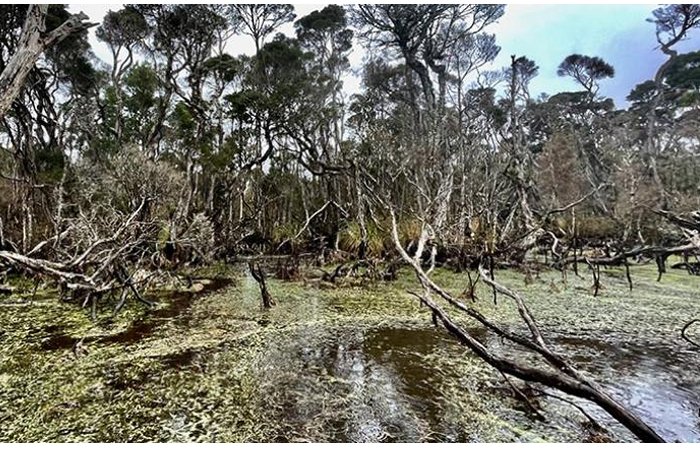Conny Waters – AncientPages.com – Some of the earliest human settlers to set foot on the island of Tasmania, more than 41, 000 years ago, engaged in advanced techniques to alter and manage their environment using fire.
Emerald Swamp, Tasmania. Image credit: Simon Haberle
This discovery suggests that these ancient inhabitants employed fire management strategies approximately 2, 000 years earlier than scholars had previously estimated.
Researchers from the United Kingdom and Australia conducted an analysis of charcoal and pollen found in ancient sediment to investigate how Aboriginal Tasmanians influenced their environment. The results show the earliest record of humans using fire to modify the Tasmanian landscape.
The early human migrations originating from Africa and extending to the southern regions of the globe were significantly advanced during the initial phase of the last ice age. Notably, humans had reached northern Australia approximately 65,000 years ago.
When the initial Palawa/Pakana communities, representing the Indigenous peoples of Tasmania, eventually made their way to Tasmania—referred to by these communities as Lutruwita—it marked a significant milestone in human migration.
This settlement represented the furthest southern point that humans had ever inhabited at that time.
There is a compelling evidence that early Aboriginal communities skillfully used fire to transform dense, wet forests for their purposes. This is clearly demonstrated by a significant rise in charcoal deposits found in ancient mud dating back 41,600 years. Such findings show that these people employed the sophisticated techniques to adapt and thrive in their environment.
The researchers show that their findings have the potential to enhance our comprehension of how humans have influenced the Earth’s environment over tens of thousands of years. Furthermore, these results could provide valuable insights into the enduring connection between Aboriginal peoples and the landscape, which is crucial for effective landscape management in contemporary Australia.
Tasmania is about 240 kilometers off the southeast Australian coast, separated by the Bass Strait. During the last ice age, a land bridge connected Australia and Tasmania, allowing foot travel until rising sea levels cut it off around 8, 000 years ago.
“Australia is home to the world’s oldest Indigenous culture, which has endured for over 50,000 years,” said Dr. Matthew Adeleye from Cambridge’s Department of Geography, the study’s lead author. “Earlier studies have shown that Aboriginal communities on the Australian mainland used fire to shape their habitats, but we haven’t had similarly detailed environmental records for Tasmania.”
The researchers conducted a study on ancient sediment samples collected from islands within the Bass Strait, a region currently recognized as part of Tasmania. Historically, during the last ice age, this area constituted a land bridge linking Australia and Tasmania. The lowered sea levels of that era contributed to the migration of Palawa/Pakana communities from the Australian mainland.
The analysis of these ancient sediments revealed a notable increase in charcoal deposits approximately 41,600 years ago. This was succeeded by a significant alteration in vegetation around 40,000 years ago, as evidenced by variations in pollen types found within the sediment layers.
“This suggests these early inhabitants were clearing forests by burning them, in order to create open spaces for subsistence and perhaps cultural activities,” said Adeleye. “Fire is an important tool, and it would have been used to promote the type of vegetation or landscape that was important to them.”
“Humans likely learned to use fire to manage forests while migrating across Sahul, the paleocontinent that included modern Australia, Tasmania, New Guinea, and eastern Indonesia, during their migration out of Africa.
“As natural habitats adapted to controlled burnings, fire-adapted species like Eucalyptus expanded, especially on the wetter eastern side of the Bass Strait islands,” said Adeleye.
Aboriginal communities in Australia still use burning practices for landscape management and cultural activities. However, using cultural burning to manage severe wildfires remains contentious. Researchers believe understanding this ancient practice could help restore pre-colonial landscapes.
“These early Tasmanian communities were the island’s first land managers. If we’re going to protect Tasmanian and Australian landscapes for future generations, it’s important that we listen to and learn from Indigenous communities who are calling for a greater role in helping to manage Australian landscapes into the future,” ” said Adeleye.
Written by Conny Waters – AncientPages.com Staff Writer


